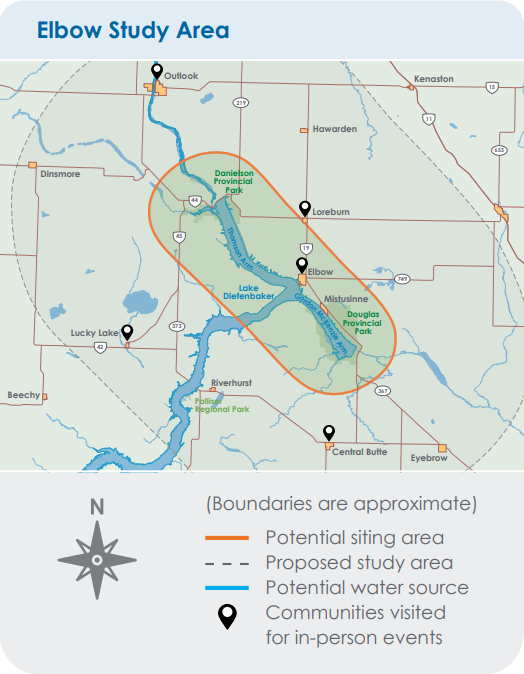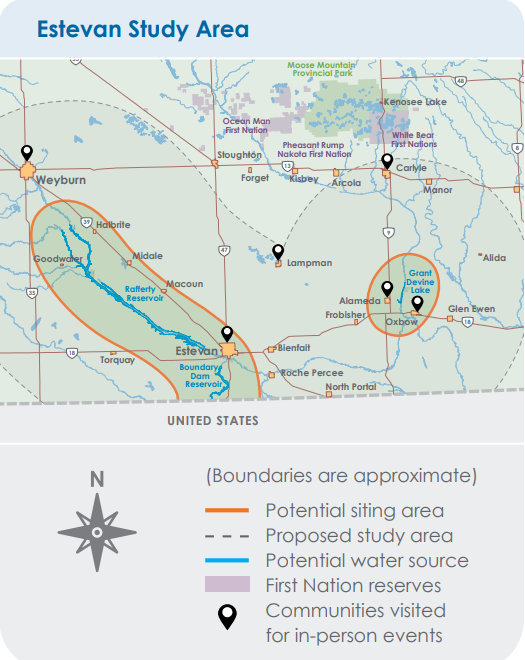SaskPower has selected two areas for further study as potential sites of a Small Modular Reactor (SMR) — the Elbow Study Area and the Estevan Study Area — and engaged with communities, stakeholders, and rightsholders for feedback on the proposals.
The Elbow Study Area encompasses a 40 km radius around the Thomson and Gordon McKenzie Arms of Lake Diefenbaker, while the Estevan Study Area is marked with a similar radius around the Boundary, Rafferty, and Grant Devine Reservoirs.
SMR represent the smallest form factor for permanently sited nuclear power plants. A joint evaluation process with the governments of Saskatchewan, Ontario, and New Brunswick resulted in SaskPower settling on the GE-Hitachi boiling water reactor.
There is no guarantee yet that Saskatchewan will add nuclear power to its baseline grid capacity — the nuclear regulatory process is strict and cannot be shortcut. Now that an SMR tech has been chosen for further evaluation, the next step is the site evaluation.
An SMR site would need the space for up to two reactors; easy access to water for cooling; proximity to the grid for uncomplicated integration; and workforce availability, housing, and logistics will all also come into account.
In this first phase of community engagement on site considerations, conducted between September and December 2022, SaskPower engaged with more than 1,400 participants through a combination of in-person and virtual sessions.
Elbow Study Area feedback
Participants in the Elbow area were primarily concerned with potential interference with Lake Diefenbaker. The lake provides a substantial proportion of Saskatchewan’s drinking water, attracts tourists, and provides year-round recreational opportunities.
The area is also part of Saskatchewan’s irrigation project, which proposes to more than double the province’s irrigable land over the next 10 years.
While nuclear power would not affect water quality, intake and outlet pumps could have an effect on the local ecosystem, and the temperature of water at the outlets is higher.
Nevertheless, participants noted that adding a clean power plant to the area could help its growth, provide jobs and economic development, and complement spin-off benefits from the irrigation project.
Some people from the region said their location was an advantage over Estevan because of their proximity to Moose Jaw, Regina, and Saskatoon. That proximity would make the plant’s logistical concerns easier to handle. Others noted gaps/opportunities such as the region only having seasonal services, lacking local first responders, and having poor roads.

Estevan Study Area
Participants in the Estevan Study Area were primarily eager at the potential of an SMR site to generate jobs and economic opportunities.
Residents fear that the federally regulated phase-out of conventional coal-fired power plants by 2030 will have a devastating economic impact on their region. Some commenters emphasized that they would prefer to keep existing coal jobs.
Other participants saw a chance to re-train coal workers and provide educational opportunities for young people to work in the nuclear power field, thus helping to securely transition the local economy away from coal.
Recreation, fish, and wildlife concerns came last on the list of priorities. Residents focused on fishing and ice fishing in the three water bodies encompassed by the study area. The warmer water temperatures caused from cooling the existing Boundary Dam coal plant are seen as a benefit at this point, attracting geese all year round.

Approximately 90 per cent of community engagement participants said the event was a good use of their time and were mostly or very satisfied.
SaskPower is currently preparing a report detailing the most frequently asked questions and providing expert answers.
A water valuation survey is open now at saskpower.com/watersurvey.
More information is available from saskpower.com/nuclear. To participate in future community engagement events and/or sign up for project newsletter, visit engage.saskpower.com.
.jpg;w=960)



